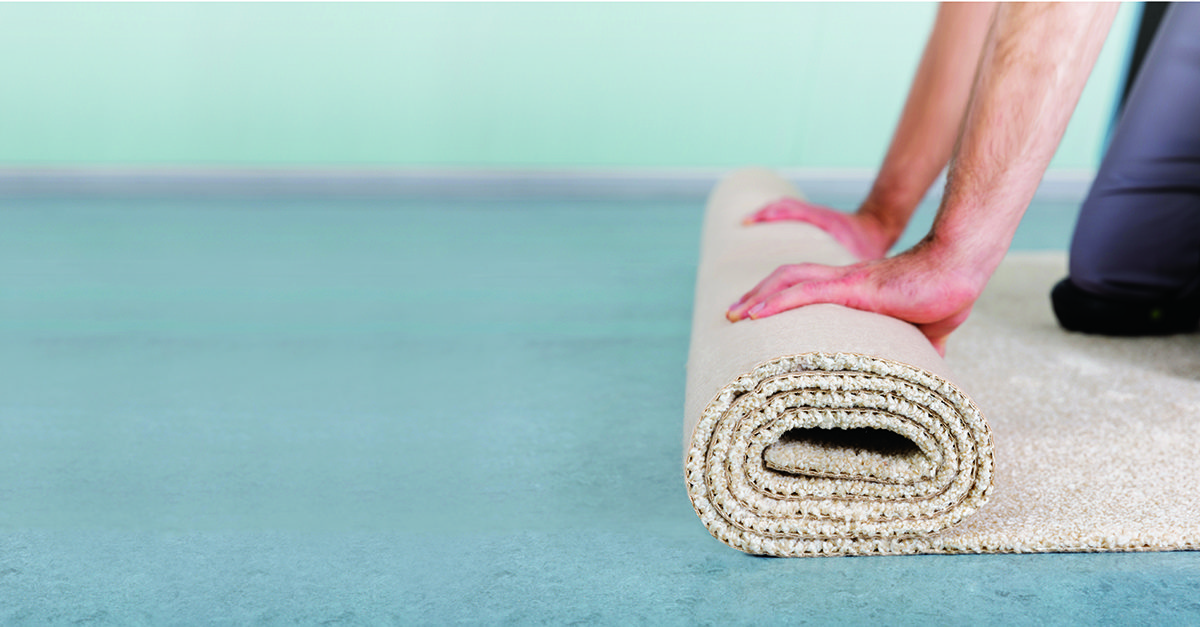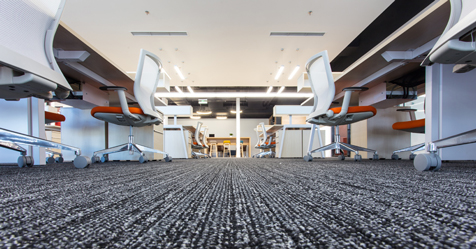Since becoming a flooring inspector in the early 1990s, I have often been asked why carpet and flooring installations fail. The client or commissioning party for the inspection wants a specific question answered, and although the answer occasionally comes easily, at other times it is complicated and takes a lot of investigation
and research.
There is a tongue-in-cheek test an inspector must take before becoming an expert. Suppose I came to you and asked, “Can you spell ‘cat’?” Would you answer “Yes” or “Yes, c-a-t”? Those are two very different answers. My question required a one-word response. I did not ask you to spell cat; I asked you if you could.
Unsurprisingly, the questions that clients ask inspectors are not so cut and dried. Here are some examples of notable questions I’ve been asked throughout my career and how I utilized the inspection process, trusted resources, and my professional experience to answer them.
Carpet seam failure
Some cases are high profile (no pun intended), such as an inspection I conducted in a 28-story condominium. In this instance, the recently installed custom carpet in the corridors was failing at the seams. Where the border was seamed and fitted into corners or where it met adjoining hard surfaces, gaps were visible between the seam edges, the pattern was mismatched, and the border pieces had detached from the seaming tape and were lifting up.
Gaps between seam edges are unacceptable, and although the pattern could have been matched, it appeared that the installer had made minimal effort to do so. The carpet was lifting at the seams where layers of seaming tape overlapped; hot-melt seaming tape will not bond to hot-melt seaming tape due to coatings applied to the back.
The client asked me if the carpet had been installed according to the manufacturer’s installation guidelines, the Carpet and Rug Institute’s CRI 104 Installation Standard for Commercial Carpet, and conventional installation practices. My answer was no.
Not all answers come easily. I spent hours walking the corridors with building management, performing the inspection, checking the pattern, and examining several seams. I spent even longer researching and writing the report. I came to my conclusion through education, training, and experience; through observation, examination, and testing; and by referencing installation guidelines from the manufacturer, the Carpet and Rug Institute, and standard installation practices.
Ceramic tile blowup
Another memorable inspection occurred at a residence where the client said the ceramic tile blew up right off the floor, sounding as though a shotgun had gone off. Upon inspection, I found that, in the dining area of the home, the ceramic tile had heaved up off the substrate.
I asked the client some questions and found out the tile floor had been fine for years, then “boom!” Why did this happen all of a sudden? What had changed?
My approach to inspections involves looking for causation clues in the entire home or building and the environment inside and out. While questioning the client, I discovered the trees in the backyard had been trimmed the previous year. The inspection was performed in late February, a time of year when, in northeast Ohio, the sun is at its lowest point in the sky and sunlight reaches far into the home. Also, the dining area was on the south side of the home.
All these factors indicated that the ceramic tile had never before been exposed to so much sunlight (thermal energy), and because the installer had not left an adequate accommodation joint (or expansion spacing), the tile and grout had no room to expand. The result: “boom!” Up it comes—because something had to give. There is more compressive strength in drywall than in most grouts and the sheer strength of most thinset mortars.
The client asked me, “Had the tile been installed according to industry guidelines and standard installation practices?” My answer was no. I based my answer on education, training, and experience; observation, examination, and testing; standard installation practices; and the EJ171 Movement Joint Guidelines from the Tile Council of North America Handbook for Ceramic, Glass, and Stone Tile Installation. This section details that movement joints are required where tile work abuts restraining surfaces such as perimeter walls and dissimilar floor finishes.
Wood cupping
During another inspection in a home, the client was concerned that the wood floors looked like a washboard.
My mind immediately went to the fact that the home was bordered by a steep hill where water visibly cascaded down its side, and I suspected that the client had a wet basement.
The area directly under the wood floor was actually a crawl space. The walls in this area showed water seepage, and the ductwork under the floor was covered with white rust.
With no dehumidifier in the adjoining basement, the relative humidity was very high. The moisture content of the joists and underside of the subfloor was high as well.
The homeowner asked me, “Why do my wood floors look like a washboard?” If the conditions inside the home and of the subfloor where the wood floor was being installed were suitable at the time of installation, the installer, dealer, or manufacturer are not to blame for the washboard effect. I concluded that the issue stemmed from the homeowner not preventing water from seeping into the crawl space, which then created inappropriate conditions under the wood floor.
According to Problems, Causes, and Cures from the National Wood Flooring Association, cupping, or this washboard effect, occurs “across the width of one piece of the flooring material,” where “the edges are high [and] the center is lower,” and it “generally develops gradually.” Further, “moisture imbalance through the thickness is the only cause. The material was manufactured flat and was flat when installed. Job site- or occupant-provided moisture is greater on the bottom of the piece than on the top.”
Carpet seam sealer
Years ago, I performed a relatively high-profile inspection at the newly opened Gund Arena—now the Rocket Mortgage Fieldhouse—in Cleveland, where the Cleveland Cavaliers play. About US$1.5 million was being withheld from the interior finishes contract because the seams of the carpet on multiple levels of the arena were sprouting yarns, fraying, and raveling.
The manufacturer hired a carpet inspector with an installation background. The inspector stated in his report that the installer had not used seam sealer. Because the carpet had a no-edge-ravel warranty, the manufacturer was ultimately on the hook to replace it. However, knowing that the installer evidently did not use seam sealer, the manufacturer declined the claim.
The interior finishes company hired me and insisted that its installers had indeed used seam sealer and even showed me containers of the used product. After inspecting the carpet and submitting my report, I met with the flooring contractor who hired me, the general manager of the arena, several members of his staff and legal team, the sales representative for the manufacturer, and the inspector the manufacturer had hired.
During this meeting, someone eventually asked, “Was seam sealer used?” I answered in the affirmative. The other inspector said no.
I knelt down to prove my answer to him and all those present. Using a carpet awl near a seam, I pulled up the carpet to show that seam sealer had been used but that it had been applied on the substrate and that the carpet had been placed on the seam sealer. Seam sealer had indeed been used—but not according to the manufacturer’s specifications or to industry standards.
I had been asked if seam sealer had been used, and my answer was yes. I had not been asked if seam sealer had been used properly.
At that point, the manufacturer’s sales rep stepped away to make a phone call. Remember, his company was on the hook to replace the carpet because the hired inspector said that seam sealer had not been used. When the sales rep returned, he asked if the carpet could be repaired, and the arena management and legal team agreed.
I assisted the union installers with taking up the carpet on one side of the seam, applying seam sealer where it is supposed to be applied, and placing the lifted edge against the still-wet seam sealer, which chemically welded the edges together. After the installers groomed and trimmed any frayed fibers along the seam edges, management was happy, the manufacturer was happy, and the flooring contractor got their money—plus a bit extra to pay me for my inspection and labor.
Dirty carpet
Two cases involving soiled carpet are particularly memorable. In the first case, the owner of a family restaurant said, “The carpet cleaner told me that he can’t get the carpet any cleaner and that it must be defective. I’m upset because it gets dirty within a week of him cleaning it. I can’t afford to clean it every week!” The carpet in question was a burgundy/black/tan, olefin, graphic-patterned, loop-pile carpet and was glue-direct installed. As we all know, oils will bond to olefin, quickly soiling in a short amount of time.
In my second carpet case, the apartment property manager said, “We can’t keep the carpet in our hallways clean. It gets dirty so fast!” The offending carpet was a gray, olefin, loop-pile carpet and was glue-direct installed. The hallways resembled large landings and included the entrances to four different apartments. This garden-style apartment development had entrances in the front and back of the buildings. Most people entered from the back because it was closer to the parking area. The property manager had a good entrance mat program, and I could see that the rubber tread steps were clean.
In both cases, the carpets had warranties for staining. Whenever I receive requests for this type of inspection, I perform a field test and clean a section of the problem areas following industry standards and protocols.
The ANSI/IICRC S100 Standard for Professional Cleaning of Textile Floor Coverings offers professionals the following guidelines:
- 1 Principles of Cleaning for Textile Floor
Coverings - Principles of Textile Floor Covering Cleaning Explained
- 1.1.1 Principle 1: Dry Soil Removal
- 1.1.2 Principle 2: Soil Suspension
- 1.1.3 Principle 3: Suspended Soil Removal
- 1.1.4 Principle 4: Pile Setting or Grooming
- 1.1.5 Principle 5: Drying
The list of cleaning protocols found within the Principles of Cleaning may appear simplistic, but this section alone takes up four pages of the standard. Carpet cleaning takes a great deal of skill, adherence to procedures, and chemistry. When I am teaching an IICRC-approved Carpet Cleaning Technician class, I spend hours discussing these principles. Each principle is broken down into multiple benchmarks for technicians to follow.
When I do field-test cleaning, I do not need to perform principle 4 or 5. In both my examples, the carpet responded well to the cleaning protocols and was perfectly restored, either matching an uninstalled sample or a section in an untrafficked area.
In the first case, even though the carpet was filthy, it could be cleaned. It took copious amounts of hot traffic lane cleaner with a citrus booster to help dissolve the grease and break the bond so it could be rinsed away (quite easily as a matter of fact).
In my second case, however, it was perplexing as to why the carpet soiled so quickly despite the existence of good preventative maintenance (entrance mats and clean stair treads). I asked about the vacuum being used and eventually tracked down the person responsible for the cleaning. I found the vacuum to be of good quality—a model from a janitorial supply company rather than a big box store. Further, the filter bag was nearly empty. This is encouraging because, in most cases, I find filter bags near the bursting point. But when I flipped the vacuum over to inspect the brush roller and belt, I found lots of fuzz and soil on the brushes, which is unusual.
I was impressed that the brushes were a good length, but when I tried to turn the brush roll, it would not turn. Upon removing the bottom plate, I found that the belt was broken—burned through, actually—because the brush roller had seized. These were important discoveries: Dry-soil removal by vacuuming is a critical preventative maintenance procedure that must be followed to maintain the appearance of the carpet and prevent rapid resoiling.
In both cases, the manufacturer asked, “Would the stained carpet come clean?” My answer was yes. The carpet was stained because the ANSI/IICRC S100 Standard and the guidelines itemized in the Principles of Cleaning section were not being followed. However, field-test cleaning restored the appearance of the carpet.
The bottom line
Even though I have been in the carpet and flooring industry for 43 years, the questions clients ask me are not always easy to answer. Finding the answers involves questioning the client and other involved parties. It requires researching manufacturer technical bulletins, installation manuals, care and maintenance guidelines, and product-specific industry standards. It means conversing with experts in technical services departments, other inspectors, adhesive and sundry manufacturers, and chemical formulators. And it calls for field tests to finally discover the root cause of a problem. That is, precisely, how to answer the questions.




